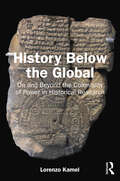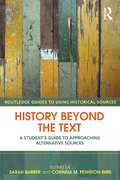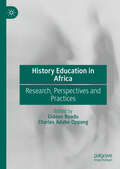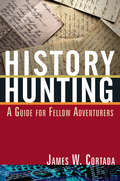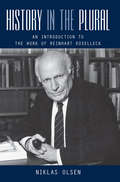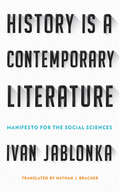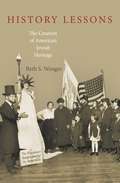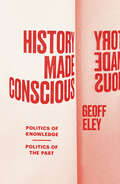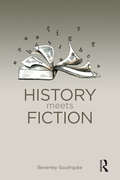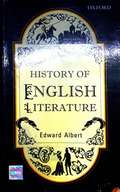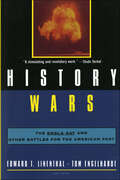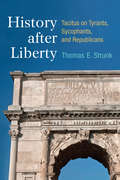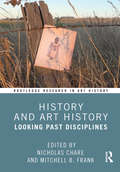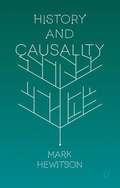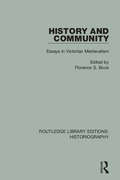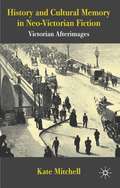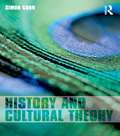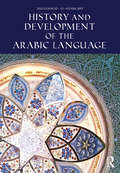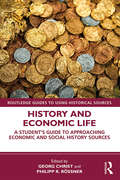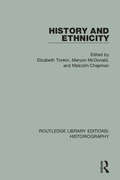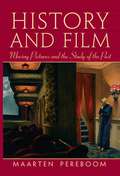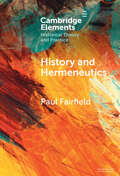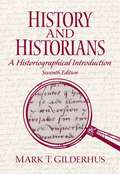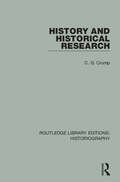- Table View
- List View
History Below the Global: On and Beyond the Coloniality of Power in Historical Research
by Lorenzo KamelHistory Below the Global aims to foster an entangled knowledge of global history, and to place "others" at the centre stage, to better understand the fluid world which we inhabit.Relying on primary sources in seven languages and books written by hundreds of African, Asian, Middle Eastern and South American scholars, Lorenzo Kamel examines the coloniality of power in historical research and sheds light on the largely neglected roles of the "others" and their modernities in history. The book provides three elements combined. Firstly, a thorough analysis of the process of accumulation (“knowledge piece by piece”) which underpins some of the major achievements in human history. Secondly, a view on pre-colonial perspectives and the process through which the latter have been swallowed up by Eurocentric and solipsistic perceptions. Lastly, a study of the roots and outcomes of colonialisms and their echoes in our present. These three elements are addressed by combining multiple methodologies and approaches, in the awareness that the history analysed, as well as the historiographical trajectories that underlie it, are ultimately inter-penetrable, as well as themselves the result of a process of accumulation. History Below the Global challenges the view that, first and foremost, the “West”, for bad and for good, is and was the centre: the proactive actor which did and undid.This volume will be of value to all those interested in global history, the history of colonialism, post-colonial studies, modern and contemporary history.
History Beyond the Text: A Student’s Guide to Approaching Alternative Sources (Routledge Guides to Using Historical Sources)
by Sarah Barber Corinna Peniston-BirdHistorians are increasingly looking beyond the traditional, and turning to visual, oral, aural, and virtual sources to inform their work. The challenges these sources pose require new skills of interpretation and require historians to consider alternative theoretical and practical approaches. In order to help historians successfully move beyond traditional text, Sarah Barber and Corinna Peniston-Bird bring together chapters from historical specialists in the fields of fine art, photography, film, oral history, architecture, virtual sources, music, cartoons, landscape and material culture to explain why, when and how these less traditional sources can be used. Each chapter introduces the reader to the source, suggests the methodological and theoretical questions historians should keep in mind when using it, and provides case studies to illustrate best practice in analysis and interpretation. Pulling these disparate sources together, the introduction discusses the nature of historical sources and those factors which are unique to, and shared by, the sources covered throughout the book. Taking examples from around the globe, this collection of essays aims to inspire practitioners of history to expand their horizons, and incorporate a wide variety of primary sources in their work.
History Education in Africa: Research, Perspectives and Practices
by Gideon Boadu Charles Adabo OppongThis collection brings together African scholars in Africa and the diaspora to contribute to scholarly debates about critical issues in history teaching and learning in African schools. The book contributes to filling the gap in knowledge on African history, associated pedagogies and practices and its consequent effects on research and the declining popularity of history in African Schools. Specifically, the volume (a) examines current trends and practices in history education in African schools, (b) unveils the challenges and subtleties of teaching the next generation of teachers and students, and (c) examines classroom practices and opportunities for engagement with historical concepts in African schools. The book adds a much-needed African voice to the international history education literature and contribute to strengthening the place of history teaching and learning in Africa.
History Hunting: A Guide for Fellow Adventurers
by James W. CortadaThe book offers guidance to aspiring historians at every stage and in every walk of life, from practical advice on tackling and organizing projects to recommendations for finding and using resources of all kinds, whether at the local library or historical society or on the world wide web. It is intended to be a serious guide to the best practices for researchers as well as a good read as a collection of research stories. The author includes useful bibliographies, vetted websites, and practical advice on doing research well.
History In The Plural
by Niklas OlsenReinhart Koselleck (1923-2006) was one of most imposing and influential European intellectual historians in the twentieth century. Constantly probing and transgressing the boundaries of mainstream historical writing, he created numerous highly innovative approaches, absorbing influences from other academic disciplines as represented in the work of philosophers and political thinkers like Hans Georg Gadamer and Carl Schmitt and that of internationally renowned scholars such as Hayden White, Michel Foucault, and Quentin Skinner. An advocate of "grand theory," Koselleck was an inspiration to many scholars and helped move the discipline into new directions (such as conceptual history, theories of historical times and memory) and across disciplinary and national boundaries. He thus achieved a degree of international fame that was unusual for a German historian after 1945. This book not only presents the life and work of a "great thinker" and European intellectual, it also contributes to our understanding of complex theoretical and methodological issues in the cultural sciences and to our knowledge of the history of political, historical, and cultural thought in Germany from the 1950s to the present.
History Is a Contemporary Literature: Manifesto for the Social Sciences
by Ivan JablonkaIvan Jablonka’s History Is a Contemporary Literature offers highly innovative perspectives on the writing of history, the relationship between literature and the social sciences, and the way that both social-scientific inquiry and literary explorations contribute to our understanding of the world. Jablonka argues that the act and art of writing, far from being an afterthought in the social sciences, should play a vital role in the production of knowledge in all stages of the researcher’s work and embody or even constitute the understanding obtained. History (along with sociology and anthropology) can, he contends, achieve both greater rigor and wider audiences by creating a literary experience through a broad spectrum of narrative modes.Challenging scholars to adopt investigative, testimonial, and other experimental writing techniques as a way of creating and sharing knowledge, Jablonka envisions a social science literature that will inspire readers to become actively engaged in understanding their own pasts and to relate their histories to the present day. Lamenting the specialization that has isolated the academy from the rest of society, History Is a Contemporary Literature aims to bring imagination and audacity into the practice of scholarship, drawing on the techniques of literature to strengthen the methods of the social sciences.
History Lessons: How Textbooks from Around the World Portray U.S. History
by Dana Lindaman Kyle WardA &“fascinating&” look at what students in Russia, France, Iran, and other nations are taught about America (The New York Times Book Review). This &“timely and important&” book (History News Network) gives us a glimpse into classrooms across the globe, where opinions about the United States are first formed. History Lessons includes selections from textbooks and teaching materials used in Russia, France, Iran, Saudi Arabia, Cuba, Canada, and others, covering such events as the American Revolution, the Cuban Missile Crisis, the Iran hostage crisis, and the Korean War—providing some alternative viewpoints on the history of the United States from the time of the Viking explorers to the post-Cold War era. By juxtaposing starkly contrasting versions of the historical events we take for granted, History Lessons affords us a sometimes hilarious, often sobering look at what the world thinks about America&’s past. &“A brilliant idea.&” —Foreign Affairs
History Lessons: The Creation of American Jewish Heritage
by Beth S. WengerMost American Jews today will probably tell you that Judaism is inherently democratic and that Jewish and American cultures share the same core beliefs and values. But in fact, Jewish tradition and American culture did not converge seamlessly. Rather, it was American Jews themselves who consciously created this idea of an American Jewish heritage and cemented it in the popular imagination during the late nineteenth and mid-twentieth centuries. History Lessons is the first book to examine how Jews in the United States collectively wove themselves into the narratives of the nation, and came to view the American Jewish experience as a unique chapter in Jewish history.Beth Wenger shows how American Jews celebrated civic holidays like Thanksgiving and the Fourth of July in synagogues and Jewish community organizations, and how they sought to commemorate Jewish cultural contributions and patriotism, often tracing their roots to the nation's founding. She looks at Jewish children's literature used to teach lessons about American Jewish heritage and values, which portrayed--and sometimes embellished--the accomplishments of heroic figures in American Jewish history. Wenger also traces how Jews often disagreed about how properly to represent these figures, focusing on the struggle over the legacy of the Jewish Revolutionary hero Haym Salomon.History Lessons demonstrates how American Jews fashioned a collective heritage that fused their Jewish past with their American present and future.
History Made Conscious: Politics of Knowledge, Politics of the Past
by Geoff EleyHow History has changed in the half-century since the 1960sDuring the last fifty years, the writing of history underwent two massive transformations. First, powered by Marxism and other materialist sociologies, the great social history wave instated the value of social explanation.Then, responding to new theoretical debates, the cultural turn upset many of those freshly earned certainties. Each challenge was profoundly informed by politics, from issues of class, gender, and race to those of identity, empire, and the postcolonial.The resulting controversies brought historians radically changed possibilities, expanding subject matters, unfamiliar approaches, greater openness to theory and other disciplines, a new place in the public culture. History Made Conscious offers snapshots of a discipline continuously rethinking its charge. How might we understand "the social" and "the cultural" together? How do we collaborate most fruitfully across disciplines? If we take theory seriously, how does that change what historians do? How should we think differently about politics?
History Meets Fiction (History: Concepts,Theories and Practice)
by Beverley C. SouthgateIs history factual, or just another form of fiction? Are there distinct boundaries between the two, or just extensive borderlands? How do novelists represent historians and history? The relationship between history and fiction has always been contentious and sometimes turbulent, not least because the two have traditionally been seen as mutually exclusive opposites. However, new hybrid forms of writing – from historical fiction to docudramas to fictionalised biographies – have led to the blurring of boundaries, and given rise to the claim that history itself is just another form of fiction. In his thought-provoking new book, Beverley Southgate untangles this knotty relationship, setting his discussion in a broad historical and philosophical context. Throughout, Southgate invokes a variety of writers to illuminate his arguments, from Dickens and Proust, through Virginia Woolf and Daphne du Maurier, to such contemporary novelists as Tim O’Brien, Penelope Lively, and Graham Swift. Anyone interested in the many meeting points between history and fiction will find this an engaging, accessible and stimulating read.
History Of English Literature
by Edward AlbertThe fifth edition of Edward Albert’s History of English Literature, first published in 1979, offers its readers a detailed view of how English literature has evolved through the centuries. Starting from the Old English period to the literature of mid-twentieth century, the book takes a look at how English literature has developed across each period. It talks about the major literary genres of each age, like poetry, prose and drama, their major proponents and offers an extensive list of the notable works published during that period. Special focus has been given to Chaucer, Shakespeare, Milton, Pope and Dryden, whose writings strongly influenced the literary output of their time. Each chapter also contains quotes, together with translations wherever needed, from the many works cited in the text. The book also comes with a broad list of writings under ‘Suggestions for Further Reading’ to guide readers who want to further explore the subject.
History Wars: The Enola Gay and Other Battles for the American Past
by Edward T. LinenthalFrom the "taming of the West" to the dropping of the atomic bomb on Hiroshima, the portrayal of the past has become a battleground at the heart of American politics. What kind of history Americans should read, see, or fund is no longer merely a matter of professional interest to teachers, historians, and museum curators. Everywhere now, history is increasingly being held hostage, but to what end and why? In History Wars, eight prominent historians consider the angry swirl of emotions that now surrounds public memory. Included are trenchant essays by Paul Boyer, John W. Dower, Tom Engelhardt, Richard H. Kohn, Edward Linenthal, Micahel S. Sherry, Marilyn B. Young, and Mike Wallace.
History after Liberty: Tacitus on Tyrants, Sycophants, and Republicans
by Thomas StrunkRoman historian Tacitus wrote a damning critique of the first century CE Roman empire. The emperors in Tacitus' works are almost universally tyrants surrounded by flatterers and informants, and the image Tacitus creates is of a society that has lost the liberty enjoyed under the Roman Republic. Yet Tacitus also poignantly depicts those who resist this tyranny and seek to restore a sense of liberty to Rome. In his portrayal of autocrats, sycophants, and republicans Tacitus provides an enduring testament to the value of liberty and the evils of despotism. History after Liberty explores Tacitus' political thought through his understanding of liberty. Influenced by modern republican writers such as Quentin Skinner and Philip Pettit, this study defines Tacitean libertas as the freedom from the rule of a dominus and as freedom to participate in the traditional politics of Rome through military service, public service in the senate and magistracies, and public speech. All of these elements are balanced in Tacitus' writings with examples of those resisting the corruption of politics in an effort to restore a sense of free civic engagement. The work concludes with an exploration of Tacitus' own writings as an act of restoring liberty. In contrast to most studies on Tacitus, History after Liberty argues that Tacitus is a republican who writes both to demonstrate that Rome had become a tyranny and to show a way out of that tyranny. History after Liberty addresses the political thought of Tacitus' writings. As such it will be of most interest to those who study the history and historiography of the early Roman empire, namely classicists and ancient historians. The work will also be of use to those interested in the antecedents to modern political thought, particularly the history of republicanism and freedom; readers from this category will include political scientists, philosophers, and modern historians.
History and Art History: Looking Past Disciplines (Routledge Research in Art History)
by Edited by Nicholas Chare and Mitchell B. FrankThrough a series of cross-disciplinary and interdisciplinary interventions, leading international scholars of history and art history explore ways in which the study of images enhances knowledge of the past and informs our understanding of the present. Spanning a diverse range of time periods and places, the contributions cumulatively showcase ways in which ongoing dialogue between history and art history raises important aesthetic, ethical and political questions for the disciplines. The volume fosters a methodological awareness that enriches exchanges across these distinct fields of knowledge. This innovative book will be of interest to scholars in art history, cultural studies, history, visual culture and historiography.
History and Causality
by Mark HewitsonThis volume investigates the different attitudes of historians and other social scientists to questions of causality. It argues that historical theorists after the linguistic turn have paid surprisingly little attention to causes in spite of the centrality of causation in many contemporary works of history. Such neglect or criticism of causality in history on a theoretical level contrasts with persisting interest in causal analysis in sociology, political science, international relations and economics; historians have criticised these disciplines for searching in vain for quantitative proofs, probabilities and covering laws. Hewitson demonstrates, through a critical analysis of a series of overlapping linguistic, cultural and post-colonial 'turns', the extent to which intellectual, social, cultural and other historians have come to renounce the very idea of causality. It uncovers the nexus between the formulation of questions, selection of evidence, use of comparison and counterfactuals, and the refinement of theories, all of which are necessary for description and narrative.
History and Community: Essays in Victorian Medievalism (Routledge Library Editions: Historiography)
by Florence S. BoosThe essays in this volume, originally published in 1992, examine some of the pervasive implications of Victorian medievalism, and assess its creative manifestations and dual capacities for expression of reformist anger and escapist retreat. Some of the emotional and intllectual reasons for the strong Victorian attraction to ‘medieval’ history and litereature are discussed and emblematic responses to this attraction are examined.
History and Cultural Memory in Neo-Victorian Fiction: Victorian Afterimages
by Kate MitchellArguing that neo-Victorian fiction enacts and celebrates cultural memory, this book uses memory discourse to position these novels as dynamic participants in the contemporary historical imaginary.
History and Cultural Theory
by Simon GunnIn recent times there has been recognition of the growing influence of cultural theory on historical writing. Foucault, Bourdieu, Butler and Spivak are just some of the thinkers whose ideas have been taken up and deployed by historians. What are these ideas and where do they come from? How have cultural theorists thought about 'history'? And how have historians applied theoretical insights to enhance their own understanding of events in the past? This book provides a wide-ranging and authoritative guide to the often vexed and controversial relationship between history and contemporary theory. It analyses the concepts that concern both theorists and historians, such as power, identity, modernity and postcolonialism, and offers a critical evaluation of them from an historical standpoint. Written in an accessible manner, History and Cultural Theory gives historians and students an invaluable summary of the impact of cultural theory on historiography over the last twenty years, and indicates the likely directions of the subject in the future.
History and Development of the Arabic Language
by Muhammad Al-SharkawiHistory and Development of the Arabic Language is a general introduction for students to the history of the Arabic language. It is divided into two parts; the pre-Islamic language up to the emergence of the first well-known works of Classical Arabic. Secondly, the transition from the pre-Islamic situation to the complex Arabic language forms after the emergence of Islam and the Arab conquests, both in Arabia and in the diaspora. The book focuses on the pre-Islamic linguistic situation, where the linguistic geography and relevant demographic aspects of pre-Islamic Arabia will be introduced. In addition, the book will also discuss the communicative contexts and varieties of Modern Arabic. The book includes readings, discussion questions and data sets to provide a complete textbook and resource for teachers and students of the history of Arabic.
History and Economic Life: A Student’s Guide to Approaching Economic and Social History Sources (Routledge Guides to Using Historical Sources)
by Philipp R. Rössner Georg ChristHistory and Economic Life offers students a wide-ranging introduction to both quantitative and qualitative approaches to interpreting economic history sources from the Middle Ages to the Twentieth Century. Having identified an ever-widening gap between the use of qualitative sources by cultural historians and quantitative sources by economic historians, the book aims to bridge the divide by making economic history sources more accessible to students and the wider public, and highlighting the need for a complementary rather than exclusive approach. Divided into two parts, the book begins by equipping students with a toolbox to approach economic history sources, considering the range of sources that might be of use and introducing different ways of approaching them. The second part consists of case studies that examine how economic historians use such sources, helping readers to gain a sense of context and understanding of how these sources can be used. The book thereby sheds light on important debates both within and beyond the field, and highlights the benefits gained when combining qualitative and quantitative approaches to source analysis. Introducing sources often avoided in culturally-minded history or statistically-minded economic history courses respectively, and advocating a combined quantitative and qualitative approach, it is an essential resource for students undertaking source analysis within the field.
History and Ethnicity (Routledge Library Editions: Historiography)
by Maryon Mcdonald Elizabeth Tonkin Malcolm ChapmanThese essays examine the importance of historical consicousness and the role of historiography in ‘ethnic’ situations, exploring the many ways in which ethnic groups select history, write or rewrite it, rescue appropriate or ignore it, forget or traduce it. Drawing on expert knowledge of regions ranging from the Amazon to contemporary Germany, the contributors bring anthropological and historical understanding to answer these questions, and investigate major topics such as the relationship between ethnic, national and state identifications, and the cultural work of creating them. Examples include Afrikaaners and Northern Ireland Protestants, as well as Mormons and Catalans. Bringing together a variety of themes that have recently become the focus of study – ethnicity, the uses and nature of history and the likelihood of objectivity in historical telling – the book will be of great interest ot students in the social sciences, anthropology, politics, history and international relations.
History and Film: Moving Pictures and the Study of the Past
by Maarten PereboomThe ability to view recorded moving pictures has had a major impact on human culture since the development of the necessary technologies over a century ago. For most of this time people have gone to the movies to be entertained and perhaps edified, but in the meantime television, the videocassette recorder (VCR), the digital versatile disk (DVD) player, the personal computer (desktop and laptop), the internet and other technologies have made watching moving pictures possible at home, in the classroom and just about anywhere else. Today, moving images are everywhere in our culture. Every day, moving picture cameras record millions of hours of activity, human and otherwise, all over the world: your cell phone makes a little video of your friends at a party; the surveillance camera at the bank keeps on eye on customers; journalists’ shoulder-carried cameras record the latest from the war zone; and across the world film artists work on all kinds of movies, from low-budget independent projects to the next big-budget Hollywood blockbuster. Moving pictures have had a great influence on human culture, and this book focuses on using moving images as historical evidence. Studying history means examining evidence from the past to understand, interpret and present what has happened in different times and places. We talk and write about what we have learned, hoping to establish credibility both for what we have determined to be the facts and for whatever meaning or significance we may attach to our reconstruction of the past. Studying history is a scientific process, involving a fairly set methodology. We tend to favor written sources, and we have tended to favor writing as a means of presenting our views of the past. But historians also use all kinds of other documents and artifacts in their work of interpreting the past, including moving pictures.
History and Hermeneutics (Elements in Historical Theory and Practice)
by Paul FairfieldPhilosophical hermeneutics has shed a good deal of light both upon the methodological underpinnings of the humanities and social sciences generally and in particular upon some fundamental issues in the philosophy of history and history proper. The aim in this Element is to analyze those of its arguments that bear directly upon the latter fields. The principal topics taken up are Dilthey's distinction between understanding and explanation, the accent on meaning and experience, and the sense in which we may be said to belong to history. Heidegger's account of historicity and being-in-the-world, Gadamer's conceptions of historical understanding and belonging, and Ricoeur's view of historians as storytellers also come in for analysis. Other themes include the sense in which we may speak of a dialogue with the past, the notion of historical truth, and the problem of constructivism.
History and Historians: A Historiographical Introduction (7th Edition)
by Mark T. GilderhusThis book presents a survey of Western historiography from ancient times to the present and shows how historians have grappled with the past in a search for meaning and how history as a body of knowledge has served different goals and purposes.
History and Historical Research (Routledge Library Editions: Historiography #11)
by C. G. CrumpAimed at students of history, this volume, originally published in 1928, examines the issues of impartiality and objectivity in the study of history. It also discusses the skills necessary for any would-be historian including the knowledge of foreign languages, the use of sources and note-taking.
